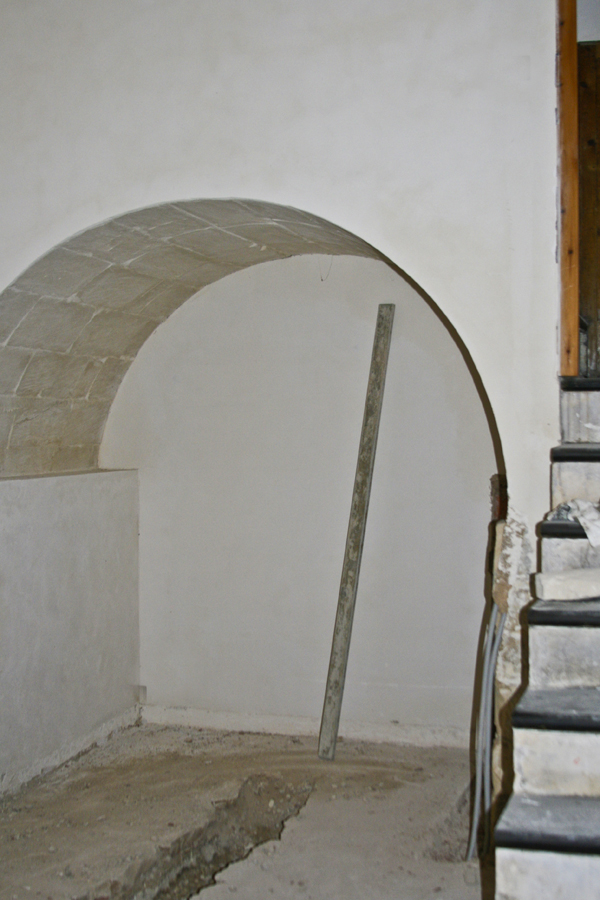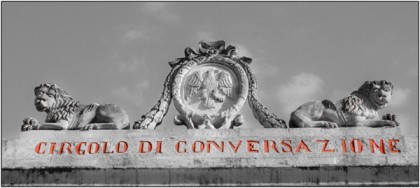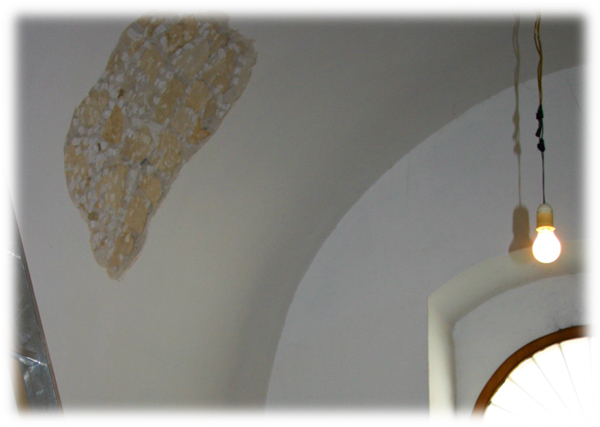April 12, 2010

…
Into the cramped space under this arch—hardly big enough for a closet—I plan to stuff an entire bathroom: sink, toilet, shower, heat rack, mirror, towel racks. The project manager is insisting on a bidet (he says no Italian can live without one), but you’d have to put your foot in the bidet to squeeze into the shower.
This is part of the cantina, the old wine cellar that is slowly morphing into guest quarters.
I plan to expose as much stone as possible inside and above the arch. The back wall, which needs to be waterproof, will be a sea of tiny tiles. Tiles the blue of a storm-tossed Ionian Sea.
Beastly expensive tiles.
I knew nothing about the cost when I ordered. I didn’t bother to ask the price. I figured: they’re just tiles made right here in Italy, not some expensive import. How much could a few little tiles cost?
The boxes finally arrived from Milan, along with the bill. My eyes popped. I had to read it over and over. I could feel my face on fire.
“Well, you ordered glass tiles,” the project manager says. What did you expect?”
I did notice how lustrous they were, but I had no idea they were glass.
I thumb through the instruction manual that comes with the tiles. The installation looks complicated. “Are you sure the mason is up to this?” I ask the project manager. The mason seems to have perfected the art of banging and pounding, but I’ve never seen him do anything delicate with his thick, calloused hands. Do I trust him with my treasures? Has he ever installed anything of the sort?
“Non preoccuparti,” says the project manager, winking. Don’t worry.
This is the favorite phrase down here. It usually means trouble.
But who am I to argue?
***
..
Click to comment.
Click to subscribe.
April 8, 2010
The men in my town are good at sitting around.

I like this; it makes the streets feel homey.
Retired guys gather at circoli, men’s clubs, like the above circolo for operai (workers) in Ragusa Ibla.

The Circolo di Conversazione for noblemen is on Piazza Duomo. Note the heavy brocade drapes and the fact that the aristocrats lounge on wooden chairs instead of plastic ones. Inside swing old cut-glass chandeliers.

The Circolo di Conversazione is across the street from the fishermen’s club. Someone told me the two groups never mingle or even exchange a buon giorno, but I’m not sure if that’s true.

Tourist tip for women in Sicily: don’t let the fixed stares of sitting-around Sicilian elders put you off. They’re curious, bored, sweet as pie. I started a conversation with these members of Circolo San Giorgio—yet another club in Ragusa Ibla—and the men responded with Old World courtesy, eager to use their schoolboy English to discuss New Jersey cousins, American politics, and World War II, when the Allies charged through the area during Operation Husky. They even invited me inside!

I wonder what the wives are doing while the husbands are sitting around.
***
Click to leave a comment.
Click to subscribe.
March 20, 2010
Chink chink. Whack whack. Hammers bounce off chisels. Lumps of plaster drop like overripe fruit exposing ancient stones, ghosts of centuries past.

I’m giddy, over the moon. And look! A stone arch where an ugly closet used to be! I love going backward in time.

But like the Sicilian saying goes: Quantu cchiù autu è lu munti, tantu cchiù profunna è la valli, the higher the mountain, the deeper the valley.
Neighbors—a stocky elderly couple—knock at the door one day just after I’ve arrived back from Rome. “Signora, there’s a problema.” They seem agitated. “Come see.”
I follow them up a flight of steps into their home. The houses in Ragusa Ibla are fitted together like jigsaw pieces; neighbors live over me, under me, to the right and to the left. The couple waves arms around and jabbers in sync. What in God’s name are they pointing at?
When my eyes adjust to the semi-darkness, I see what must be dozens of cracks like spider legs crawling over the walls. Bad news indeed, but what do these blessed spider legs have to do with me?
“Signora, all the pounding away in your house has ruined our walls.”
For a minute the room lacks oxygen. Are these cracks really new? Sicily is on a fault line. This could have happened years ago. I want to bring up these ideas, but of course I don’t. Instead I say in a voice sharp as a prickly pear, “Let me speak to the project manager. We’ll resolve this.”
Things are getting tangled up. Cu’ havi terra, havi guerra, Sicilians say, owning land is like fighting a war.
What will this cost? I’m hemoragging cash. The dollar is at an all-time low. I consult with Sicilians in the know.
Mason: No way we could we have done that. Impossibile. You’d be a fool to pay a centesimo.
Friend 1: Sicilians see Americans as a giant slot machine. Don’t pay.
Project Manager: It’s possible we did cause the cracks. We’ll never know. Pay up. Keep the peace.
Friend 2: It’s extortion, pure and simple.

Have they typecast me? The lady with the American dollars? Have I destroyed their walls? Do I now have two houses to restore? What to do?
Click here to comment.
March 10, 2010
xx
My husband, newly arrived on the scene, has clawed his way down to stone. I phone the project manager with the news.
The crew turns up the next day with hammers and chisels. Now that Kim is here, the garrulous workers completely ignore me, peppering him with questions and concerns—never mind that he doesn’t speak one iota of Italian.
Something about a manly presence in the house has lit a fire under the crew. They really get cracking. Chink chink chink. Chunks of plaster fall like overripe fruit, unveiling enormous blocks of tawny stone.

Madonna! They look pretty freakin’ old. I’m prone to wild mood swings in Sicily, and now I’m on the upswing.
“Stones from the old Norman castello!” say nosey neighbors who wander in the house through the open front door, wondering what all the racket is.
They tell me the entire neighborhood scavenged rubble from the castle that once stood on this site before it crumbled in Ragusa Ibla’s great earthquake of 1693.
 Norman castle in Ragusa Ibla before 1693 earthquake, copyright S. Tumino Finding the ancient Norman rocks is a delicious surprise.
There are more surprises to come in the near future, though none nearly so pleasant.
***
xxx
Win this book!!!!!
I love this tiny up-to-date (2009) guidebook. It packs in information in the form of many top 10 lists. It includes charming out-of-the-way places—the author knows the hidden nooks and crannies of Sicily—and a few fold-out maps.
HOW? Between now and March 26, write a comment on any of my blogposts. The best comment wins. (“Best” could be funniest, most enlightening, most touching…)
March 1, 2010
The roof’s been fixed; the rain’s been staunched.

xxx
…xxxxx
…
xxx
xxx
I turn my attention to the interior of the house.
Please find me some old stones, I implore. Vi prego. There must be stone under the many layers of plaster and wall tile. Let’s expose it!
“What do you need old stones for, anyway? asks the project manager, tossing his head impatiently. “If you want stone, we can put pietra finta, fake stone, on the walls.”
Fake stone? Could he be serious?
“It’ll be faster and cheaper than looking all over the house for old stone. It looks better, too.”
“But,” I wail, “I love old stuff! We don’t have old stuff in the Stati Uniti!!!! That’s why I’m in Sicily!”
I long to wrap history around me like a well-worn cape. Sicilians, having lived among ruins for millennia, want to shed the old cape for something flashier.
***
A week or so later, I get a call in Rome. “Non c’e pietra.” There’s no stone.
I’m stunned. This is an old Sicilian house. There has to be stone. Or have I managed to purchase the one and only stone-free house in all of Italy?
***
There’s a new twist to the plot. My husband decides to travel from the U.S. to far-flung Ragusa Ibla to see for himself what’s going on. It’s the first time he and the house will meet—nearly a year after I’ve bought it—and I’m nervous. His interest in the project has not been keen. What’ll he think?
When he arrives at our mossy-smelling home late one afternoon, there’s rubble wherever you look. He wears a fixed frown and raises an eyebrow.
Then he hunts around for a tool. There’s nothing in the house but a vintage can opener. He climbs a ladder in the salone and starts scratching at the vaulted ceiling. He claws away with his rusty little can opener until fingers start to bleed.
“So who says there’s no pietra,” he yells from atop the ladder. “Look at this.”
Peeking through the plaster is a hint of beautiful stone.

x
He comes down from the ladder and steps onto the balcony with a wan smile. Plaster has settled into his hair. The sky is full of evening light; the bells toll as if they’re going mad. The small smile transforms into a dual-dimpled grin.
x

Click to leave a comment.
Click to subscribe. (It’s free.)
|
Subscribe to Baroque Sicily
Copyright reserved -
All photos and text on BaroqueSicily are Copyright of Jann Huizenga ©2009-2015, unless otherwise noted. Material may not be copied or re-published without written permission. All rights reserved.
|



















